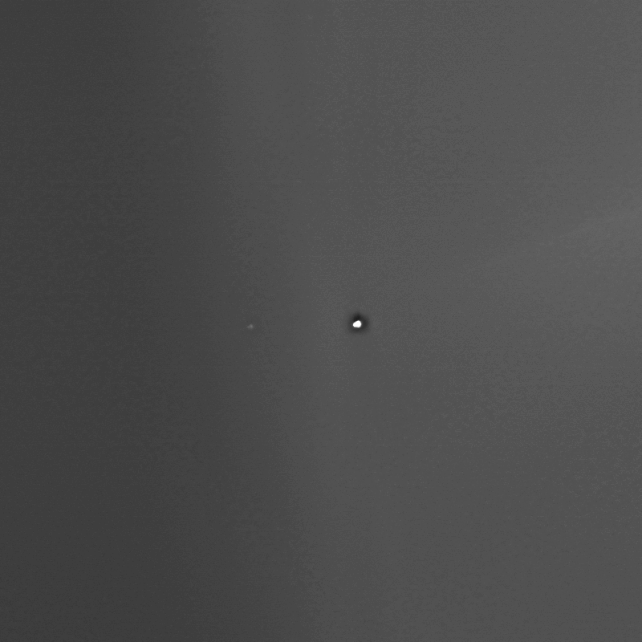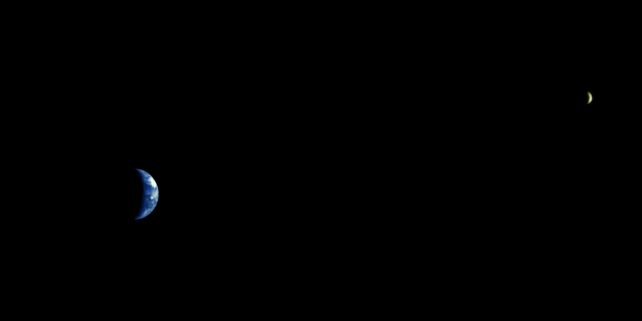Products You May Like
It doesn’t look like much: a fuzzy gray scene, a fuzzy white blob in the center, a smaller, fainter fuzzy blob moving from left to right across the scene.
What you’re looking at, though, is a marvel of science and engineering. It’s the view from the camera of a robotic orbiter named Mars Express, peering back towards its homeworld across a vast gulf of 300 million kilometers (186.4 million miles).
That white blob is the Sun. And the fainter, smaller blob is Earth and the Moon, moving across the sky.

The sequence of images was captured to commemorate 20 years since Mars Express departed for redder, drier shores, and if you were 300 million kilometers from home, and hadn’t been back for 20 years, you might feel homesick for a fuzzy blob, too.
Even more, though, the images invoke an image of Earth taken by Voyager 1 in 1990 as it traveled out of the Solar System, poetically described by Carl Sagan, in his 1994 book Pale Blue Dot.
“On the special occasion of Mars Express’s 20th anniversary since launch, we wanted to bring Carl Sagan’s reflections back to the present day, in which the worsening climate and ecological crisis make them more valid than ever,” says astronomer Jorge Hernández Bernal of the University of the Basque Country in Spain and Sorbonne University in France.
“In these simple snapshots from Mars Express, Earth has the equivalent size as an ant seen from a distance of 100 meters, and we are all in there. Even though we have seen images like these before, it is still humbling to pause and think: we need to look after the pale blue dot, there is no planet B.”

The images were taken on 15, 21, and 27 May, and 2 June 2023, using the super resolution channel of Mars Express’s High Resolution Stereo Camera, usually used for observing the two Martian moons, and the stars around the planet.
They have, the Mars Express team say, no scientific value, but the opportunity to take them presented itself, so that’s what the team did.
Here’s what Sagan had to say about the Voyager image.
“That’s here. That’s home. That’s us. On it everyone you love, everyone you know, everyone you ever heard of, every human being who ever was, lived out their lives,” he wrote.
“The aggregate of our joy and suffering, thousands of confident religions, ideologies, and economic doctrines, every hunter and forager, every hero and coward, every creator and destroyer of civilisation, every king and peasant, every young couple in love, every mother and father, hopeful child, inventor and explorer, every teacher of morals, every corrupt politician, every ‘superstar,’ every ‘supreme leader,’ every saint and sinner in the history of our species lived there – on a mote of dust suspended in a sunbeam.”

The first image of Earth taken by Mars Express was taken 20 years ago as it was departing, on 3 July 2003. From a distance of 8 million kilometers, Mars Express snapped a pic of the Earth-Moon system, serene and small in the void of space.
Mars science has come a long way since then, and we have bigger plans for the future, including a crewed mission to visit the red planet in person, for the first time. Mars Express continues to deliver fascinating insights into our planetary neighbor, and its data will help shape those future missions.
“Perhaps,” says astronomer Colin Wilson of the European Space Agency, “it will only be another 20 years before humans can look up from the surface of Mars to see Earth in the night sky.”
